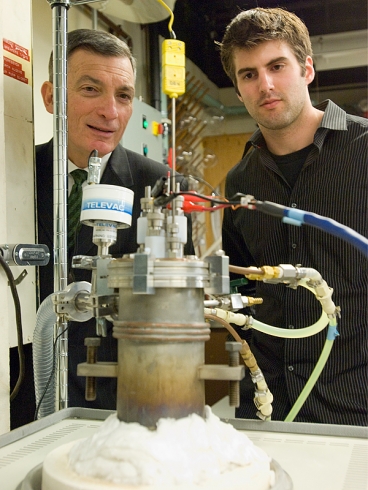MIT - making big liquid batteries for Electric grids?
 |
| If fully Evolved- it can be a big boon to Renewable Energy |
There’s one major drawback to most proposed renewable-energy sources: their variability. The sun doesn’t shine at night, the wind doesn’t always blow, and tides, waves and currents fluctuate. Even in conventional systems sometimes load vary, sometimes there will be a peak load, sometimes load on the grid will be less. A large battery storage can save fuel . But there is no such a storage system for electricity on large scale. That’s why many researchers have been pursuing ways of storing the power generated by the sources(non-convetional and conventional) so that it can be used when it’s needed.
So far, those solutions have tended to be too expensive, limited to only certain areas, or difficult to scale up sufficiently to meet the demands. Many researchers are struggling to overcome these limitations, but MIT professor Donald Sadoway has come up with an innovative approach that has garnered significant interest — and some major funding.
The idea is to build an entirely new kind of battery, whose key components would be kept at high temperature so that they would stay entirely in liquid form. The experimental devices currently being tested in Sadoway’s lab work in a way that’s never been attempted in batteries before.
Most battery research, Sadoway says, has been aimed at improving storage for portable or mobile systems such as cellphones, computers and cars. The
requirements for such systems, including very low weight and high safety, are very different from the needs of a grid-scale, fixed-location battery
system. “What I did was completely ignore the conventional technology used for portable power,” he says. The different set of requirements
for stationary systems “opens up a whole new range of possibilities.”
A large, utility-owned system “doesn’t have to be crash-worthy; it doesn’t have to be ‘idiot-proof’ because it
won’t be in the hands of the consumer.” And while consumers are willing to pay high prices, pound-for-pound, for the small batteries used
in high-value portable devices, the biggest constraint on utility-sized systems is cost. In order to compete with present fossil-fuel power systems,
he says, “it has got to be cheap to build, cheap to maintain, last a long time with minimal maintenance, and store enormous amounts of
energy.”
The energy is stored in the liquid metals that want to react with one another but can do so only by transferring ions — electrically charged
atoms of one of the metals — across the electrolyte, which results in the flow of electric current out of the battery. When the battery is being
charged, some ions migrate through the insulating salt layer to collect at one of the terminals. Then, when the power is being drained from the
battery, those ions migrate back through the salt and collect at the opposite terminal.
The whole device is kept at a high temperature, around 700 degrees Celsius, so that the layers remain molten. In the small devices being tested in the
lab, maintaining this temperature requires an outside heater, but Sadoway says that in the full-scale version, the electrical current being pumped
into, or out of, the battery will be sufficient to maintain that temperature without any outside heat source.
While some previous battery technologies have used one liquid-metal component, this is the first design for an all-liquid battery system, Sadoway
says. “Solid components in batteries are speed bumps. When you want ultra-high current, you don’t want any solids.”
The laboratory tests have provided “some measure of confidence,” Sadoway says. But many more tests will be needed to
“demonstrate that the idea is scalable to industrial size, at competitive cost.” But while he is very confident that it will all work,
there are a lot of unknowns, he says, including how to design and build the necessary containers, electrical control systems, and connections.
“We’re talking about batteries of a size never seen before,” he says. And the system they develop has to include everything,
including control systems and charger electronics on an unprecedented scale.
For Sadoway, the project is worth pursuing despite its daunting challenges, because the potential impact is so great. “I’m not doing this
because I want another journal publication,” Sadoway says. “It’s about making a difference … It’s an opportunity to
invent our way out of the energy problem.”
